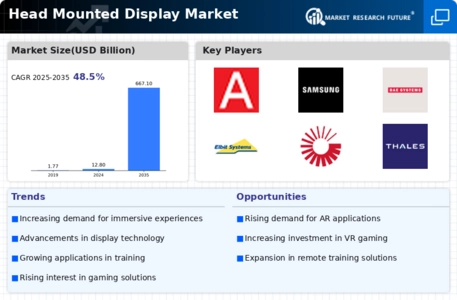Top Industry Leaders in the Head Mounted Display Market

The Competitive Landscape of the Head Mounted Display Market
The head-mounted display (HMD) market is experiencing explosive growth, fueled by advancements in technology, increasing affordability, and diverse applications across various industries. This dynamic landscape is characterized by a mix of established players and emerging challengers, each vying for a slice of the pie.
Key Player:
- Alphabet Inc.
- Sony Corporation
- SAMSUNG
- Microsoft Corporation
- BAE Systems
- Elbit Systems Ltd.
- FUJITSU
- HTC Corporation
- Huawei Technologies Co. Ltd.
Strategies Adopted by Key Players:
In this competitive environment, companies are employing diverse strategies to differentiate themselves. Some, like Meta, focus on building comprehensive ecosystems with user-friendly hardware, robust software platforms, and content libraries. Others, like HTC and Valve, prioritize high-end hardware for enthusiasts and professionals. AR players like Magic Leap and Nreal target specific use cases with specialized features, catering to enterprise needs and niche markets.
Factors for Market Share Analysis:
- Technology: Advanced features like high-resolution displays, wide field of view, accurate hand tracking, and haptic feedback influence user preference and market segmentation.
- Content: A rich and diverse content ecosystem across gaming, entertainment, productivity, and enterprise applications attracts and retains users.
- Price: Balancing affordability with technological advancements is crucial, especially for reaching mass consumer markets.
- Partnerships: Strategic collaborations with content creators, software developers, and industry leaders can expand reach and influence adoption.
- Distribution channels: Effective partnerships with retailers and online platforms ensure wider product availability and user accessibility.
New and Emerging Companies:
The HMD market is constantly evolving, with new companies entering the fray. Startups like Lynx, Pico Interactive, and Miramar are developing VR headsets with unique features and competitive price points, potentially disrupting the established order. Additionally, tech giants like Apple and Google are rumored to be entering the AR/VR space, further intensifying competition.
Latest Company Updates:
Alphabet Inc.
- Project Starline: Announced in 2022, Project Starline is a high-resolution, real-time 3D video conferencing system that creates the illusion of sitting face-to-face with another person. Google showcased an updated version at CES 2023 with improved resolution and field of view.
- Google Glass Enterprise Edition 2: Released in March 2020, Google Glass 2 is an enterprise-focused AR headset aimed at improving worker productivity and training. Google remains tight-lipped about further developments, but rumors suggest a new version might be unveiled in 2024.
- Investment in Magic Leap: In 2020, Google invested $50 million in Magic Leap, another AR headset manufacturer. This suggests Google's continued interest in the AR space and potential future collaborations.
Sony Corporation
- PlayStation VR2: Announced in February 2023, PS VR2 is the upcoming virtual reality headset for the PlayStation 5 console. It boasts improved features like eye tracking, haptic feedback in the headset itself, and enhanced controllers. Release is expected in early 2024.
- Spatial Reality Display: In October 2022, Sony revealed a prototype "Spatial Reality Display" at CES. This glasses-free 3D display uses eye-tracking technology to create a personalized 3D viewing experience without the need for a headset. No release date has been announced.
- Mocopi motion capture system: Launched in July 2023, Mocopi is a wireless motion capture system using small, clip-on trackers. It can be used for animation, game development, and other VR/AR applications.








